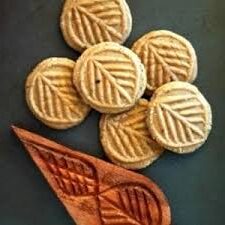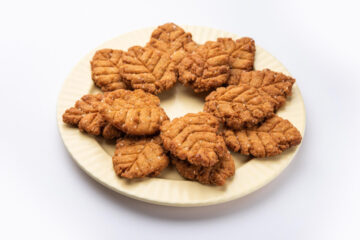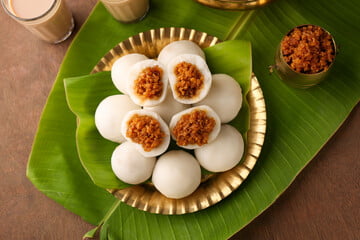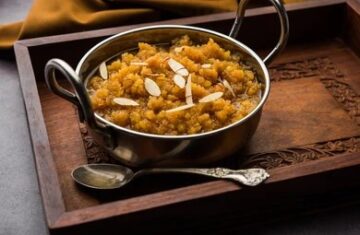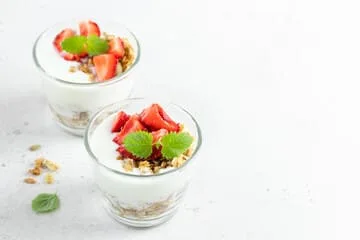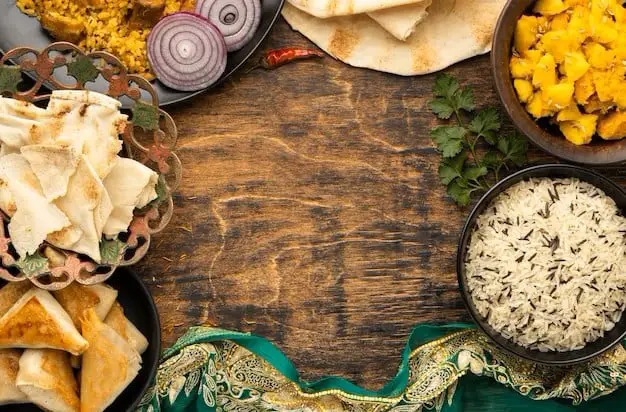This is it, food lovers! Today I am very excited to share one of my absolute favorite traditional Indian recipes – the incredible thekua. These crispy, sweet cookies are basically the heart and soul of Bihar’s Chhat Puja celebrations, but trust me, they’re so good that you’ll want to make them any time of the year!
Table of Contents
What’s So Special About Thekua?
Let me tell you something amazing about Thekua – it’s absolutely not your everyday cookie!When I first discovered this traditional delicacy, I was amazed by how simple ingredients like wheat flour and jaggery could produce something so incredible. The key is how these modest ingredients combine with fragrant spices to convert into crispy, golden perfection when fried. What makes me smile even more is that Thekua (or Thekuwa or Khajuria, as some folks call it) keeps its deliciousness intact for weeks! So whether you’re a busy mom wanting to keep your cookie jar stocked or just someone who loves having homemade treats handy, these little wonders won’t let you down.
Let’s Get Cooking!
Ingredients You’ll Need:
For the dough:
- 2 cups whole wheat flour (atta)
- 1 cup powdered jaggery (or to taste)
- ¼ cup ghee (trust me, it makes a difference!)
- ½ teaspoon cardamom powder
- 2-3 tablespoons fennel seeds
- A pinch of ginger powder (optional, but recommended)
- Warm water (as needed)
- Oil for deep frying
Essential Tools:
- A heavy-bottom kadai or deep pan
- A Thekua mold (don’t worry if you don’t have one – I’ll share alternatives!)
- Mixing bowls
- Sieve
The Step-by-Step Magic
1. Prep Work (The Foundation of Perfect Thekua)
First things first, let’s get everything organized. I learned this the hard way – preparation is key to stress-free Thekua making!
- Sieve the wheat flour to remove any lumps
- Powder the jaggery finely (if not already powdered)
- Lightly roast the fennel seeds until fragrant
- Keep your Thekua mold ready (or alternatives)
2. Making the Dough
This is where the magic begins! The key is getting the right consistency – not too soft, not too hard.
- In a large bowl, mix the sieved wheat flour with the powdered jaggery
- Mix the roasted fennel seeds, cardamom powder, and ginger powder.
- Now comes the important part – add the ghee
- Using your fingertips, mix the ghee thoroughly with the flour mixture until it resembles breadcrumbs
- Gradually add warm water, little by little, kneading into a firm dough
- Allow it to rest for 15-20 minutes, covered.
Pro Tip: The dough should be firmer than regular roti dough but not so hard that you can’t work with it.
3. Shaping Your Thekua
Now here’s where you can get creative! Traditionally, Thekua is shaped using a wooden mold, but don’t let the lack of one stop you.
- Take a lemon-sized portion of dough
- Roll it into a smooth ball
- Press it into the mold
- Tap the mold gently on your work surface – the Thekua should fall out beautifully patterned
No Mold? No Problem!
- Use cookie cutters
- Make simple patterns with a fork
- Roll out small portions and make designs with your fingers
4. The Frying Process
This is crucial – the right temperature makes all the difference between perfect and “meh” Thekua.
- Heat oil in your kadai on medium heat
- To test if the oil is ready, drop a tiny piece of dough – it should rise to the surface slowly
- Carefully slide in the shaped Thekua
- Fry on medium heat until golden brown
- Drain on paper towels
Pro Tip: Don’t overcrowd the kadai – give your Thekua space to swim!
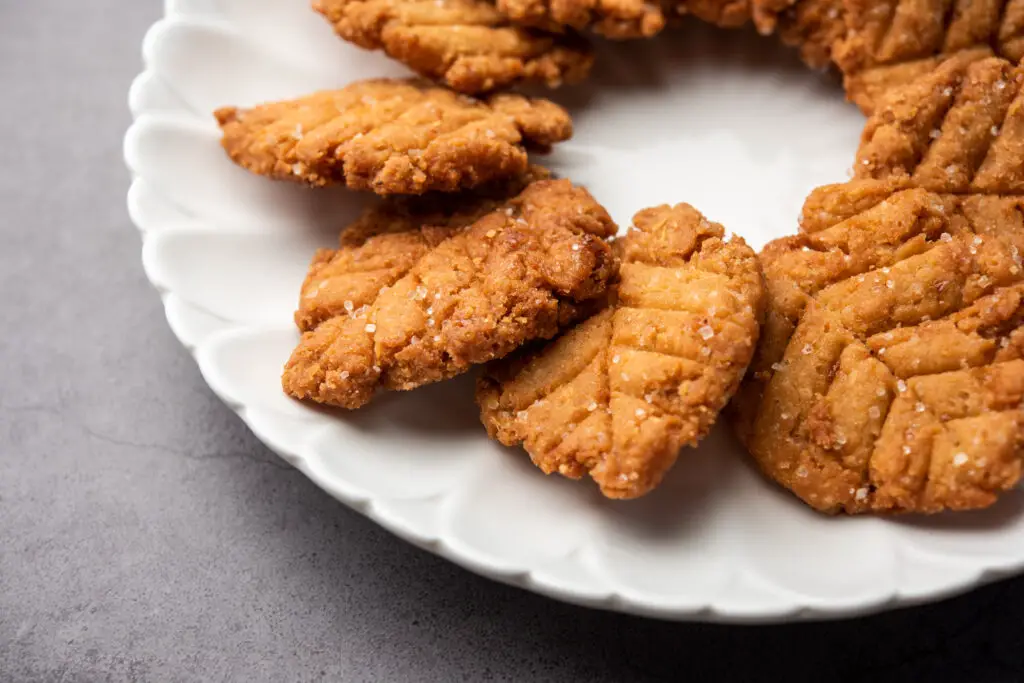
Troubleshooting Tips
If Your Dough Is Too Sticky:
- Add a little more flour
- Work quickly with slightly oiled hands
If Your Thekua Is Breaking:
- The dough might be too soft
- Try adding a bit more flour and knead again
If They’re Not Crispy:
- The oil temperature might be too high
- Ensure medium heat throughout frying
Storage Secrets
One of the best things about Thekua is how well it keeps! Here’s how to make them last:
- Cool completely before storing
- Use an airtight container
- They can last up to 3-4 weeks at room temperature
- Layer them with parchment paper to prevent sticking
Modern Twists on Traditional Thekua
While I’m all for tradition, sometimes it’s fun to experiment! Here are some variations I’ve tried:
Healthy(ish) Version:
- Replace some jaggery with stevia
- Add ground flaxseeds for extra nutrition
- Use a mix of whole wheat and oat flour
Flavored Versions:
- Add crushed nuts
- Mix in some desiccated coconut
- Experiment with spices like cinnamon or nutmeg
Perfect Pairings
Thekua is fantastic on its own, but try these combinations:
- Hot masala chai on a rainy day
- Coffee for a morning treat
- Warm milk before bed
Seasonal Specials
Change up your Thekua experience with the seasons:
- Summer: Pair with cooling lassi or chaas
- Monsoon: Hot ginger tea and Thekua make rainy days perfect
- Winter: Try with Kashmiri kahwa or hot chocolate
- Spring: Light green tea makes a refreshing combination
Modern Twists
For those who love experimenting:
- Crumble Thekua over vanilla ice cream
- Dip in melted dark chocolate
- Serve with a fruit smoothie
- Use as a base for quick desserts
Nutrition Guide: Understanding Your Thekua
Let me break down the nutritional aspects of Thekua in a way that helps you make informed choices while enjoying this traditional delight!
Basic Nutritional Profile (Per Piece, Approx. 30g)
- Calories: 140-150 kcal
- Carbohydrates: 22-24g
- Protein: 2-3g
- Fat: 5-6g
- Fiber: 1-2g
- Iron: 0.8-1mg
- Calcium: 15-20mg
Key Nutritional Components
Whole Wheat Flour Benefits
- Rich in dietary fiber
- Contains B vitamins
- Good source of minerals
- Provides sustained energy
- Better than refined flour for blood sugar control
Jaggery Advantages
- Natural source of iron
- Contains minerals like magnesium and potassium
- Better alternative to refined sugar
- Rich in antioxidants
- Aids in digestion
Ghee Benefits
- Contains healthy fatty acids
- Rich in fat-soluble vitamins (A, D, E, K)
- Supports joint health
- Aids in nutrient absorption
- Better choice than refined oils
Spice Benefits
Cardamom:
- Aids digestion
- Natural breath freshener
- Anti-inflammatory properties
- Rich in antioxidants
Fennel Seeds:
- Supports digestive health
- Rich in fiber
- Contains essential oils
- Natural mouth freshener
Health Considerations
Moderation is Key
- Being a deep-fried sweet, portion control is important
- Best consumed as an occasional treat
- Ideal serving size: 1-2 pieces per sitting
Who Should Be Cautious
- Diabetics (due to jaggery content)
- People watching their calorie intake
- Those with gluten sensitivity
- Individuals on a low-fat diet
Healthier Adaptations
- For Diabetics:
- Reduce jaggery quantity
- Use sugar substitutes partially
- Smaller portion sizes
- For Weight Watchers:
- Bake instead of frying
- Use less ghee
- Control portion size
- For Heart Health:
- Use minimal oil for frying
- Choose healthier oil options
- Reduce ghee quantity
Storage and Nutrition Retention
- Keeps well for 3-4 weeks in airtight container
- Maintains nutritional value when stored properly
- Avoid exposure to moisture to prevent nutrient loss
- Store in a cool, dry place
Best Time to Consume
- Morning: As a breakfast treat with tea
- Evening: Perfect tea-time snack
- Post-workout: Good carb replenishment
- Festival times: Traditional consumption
Special Notes
For Children
- Good source of energy
- Contains essential minerals
- Better than packaged cookies
- Moderation is important
For Elderly
- Easy to digest when dunked in tea
- Good source of traditional nutrients
- Satisfying sweet craving healthily
- Rich in iron and calcium
For Active Adults
- Quick energy source
- Better than processed snacks
- Good pre-workout snack
- Contains complex carbohydrates
Tips for Maximum Nutritional Benefits
- Preparation Tips:
- Don’t overheat the oil
- Use fresh ingredients
- Store properly
- Maintain hygiene
- Consumption Tips:
- Best eaten fresh
- Pair with protein-rich beverages
- Avoid on empty stomach
- Enjoy mindfully
Remember, while Thekua is a traditional sweet treat, understanding its nutritional profile helps us enjoy it responsibly. It’s about finding the right balance between savoring our cultural delicacies and maintaining a healthy lifestyle.
The beauty of Thekua lies not just in its taste but also in its use of wholesome ingredients. When enjoyed in moderation, it can be part of a balanced diet, especially during festive seasons!
.
Essential Questions About Thekua
Preparation Questions
Q: Can I make the dough ahead of time?
A: Yes, but don’t store it for more than 2-3 hours. The dough tends to dry out and can become difficult to shape. Keep it covered with a damp cloth if you need to store it briefly.
Q: I don’t have a traditional mold. What can I use instead?
A: Don’t worry! You can use:
- Regular cookie cutters
- The back of a fork for patterns
- A clean bottle cap for simple round shapes
- Your hands to make simple designs
Q: Why is my dough crumbly?
A: This usually happens when:
- There’s not enough moisture
- The ghee wasn’t mixed properly
- The water wasn’t warm enough
Solution: Add warm water gradually and knead until you get a firm but pliable dough.
Ingredient Questions
Q: Can I use regular sugar instead of jaggery?
A: Yes, but remember:
- Reduce the quantity by 25% as sugar is sweeter
- The color will be lighter
- The traditional taste will differ slightly
- You might miss out on jaggery’s nutritional benefits
Q: Is refined flour (maida) a good substitute for whole wheat?
A: While you can use it:
- The texture will be different
- They’ll be less nutritious
- The authentic taste will change
Stick to whole wheat for traditional taste and better health benefits.
Q: Can I skip fennel seeds?
A: You can, but they:
- Add distinctive flavor
- Help with digestion
- Contribute to the traditional aroma
Consider reducing the quantity rather than skipping entirely.
Cooking Process Questions
Q: How do I know when the oil is at the right temperature?
A: Here’s a simple test:
- Drop a tiny piece of dough into the oil.
-It should gently rise to the surface. - If it rises too soon, the oil is too hot.
- If it sinks, the oil is not hot enough.
Q: Why do my Thekuas break while frying?
A: Common reasons include:
- Dough is too soft
- Oil temperature is too high
- Cookies are too thin
- Dough wasn’t rested enough
Q: How long should I fry each batch?
A: Typically 3-4 minutes on medium heat until:
- They turn golden brown
- Both sides are evenly cooked
- When tapped, they produce an empty sound.
Storage Questions
Q: How long do Thekuas really last?
A: When stored properly:
- 3-4 weeks at room temperature
- Up to 6 weeks in an airtight container
- Longer in cooler climates
- Less time in humid conditions
Q: What’s the best way to store them?
A: Follow these tips:
- Use an airtight container
- Layer with parchment paper
- Keep away from direct sunlight
- Store in a cool, dry place
Troubleshooting Questions
Q: Why aren’t my Thekuas crispy?
A: This could be due to:
- Oil temperature fluctuations
- Too much moisture in the dough
- Not fried long enough
- Improper storage after cooking
Q: Why do they turn dark too quickly?
A: Common causes:
- Oil is too hot
- Too much jaggery in the dough
- Dough pieces are too thin
- Frying too many at once
Health-Related Questions
Q: Can diabetics eat Thekua?
A: With modifications:
- Use sugar substitutes
- Reduce the sweetener quantity
- Make smaller pieces
- Consult healthcare provider for portions
Q: Are they suitable for a gluten-free diet?
A: Traditional Thekua isn’t gluten-free, but you can experiment with:
- Gluten-free flour blends
- Rice flour combinations
- Millet flour alternatives
Note: The texture will be different
Special Occasion Questions
Q: Can I make a large batch for festivals?
A: Yes! Tips for bulk preparation:
- Make dough in smaller batches
- Keep oil temperature consistent
- Work with a helper if possible
- Plan your storage strategy
Q: How to pack them for gifting?
A: Best practices include:
- Cool completely before packing
- Use food-grade containers
- Layer with parchment paper
- Keep away from moisture
Remember, making perfect Thekua comes with practice. Don’t be discouraged if your first batch isn’t perfect – each attempt brings you closer to mastering this traditional delight!
Cultural Significance
Thekua isn’t just food; it’s emotion. During Chhath Puja, these cookies are offered as prasad and symbolize the sun god’s blessings. They’re also shared among family and friends, strengthening bonds and creating memories.
Final Thoughts
Making Thekua always makes me think of joyful excitement and community festivities. The way that this straightforward confection unites generations and maintains our culinary legacy is quite remarkable.
Tell me about your experiences creating Thekua! Have you experimented with any intriguing variations? What was your family’s response to these customary treats? Keep in mind that every baker contributes a chapter to the tale that every kitchen tells. I hope your Thekuas are crispy, sweet, and full of love. 🌟
How to Make Thekua
Hey there! Let me tell you about this amazing traditional cookie called Thekua that's super easy to make at home!
Start by mixing whole wheat flour with crushed jaggery, some aromatic fennel seeds, and ghee – just knead them together until you get a nice firm dough that feels a bit tougher than your regular chapati dough.
The fun part comes next – roll small portions into balls, press them into pretty patterns using a mold (or just make some cute designs with a fork if you don't have one), and get ready for the magic!
Drop these thekuas into medium-hot oil and watch them turn into gorgeous golden-brown cookies – they take just a few minutes to fry up perfectly crispy on the outside while staying slightly chewy inside, and oh my goodness, the smell of fennel and jaggery together is absolutely heavenly!
The best part? These delicious treats can hang out in your cookie jar for up to three weeks (if they last that long!), making them perfect for festivals like Chhath Puja or just as a yummy snack with your evening chai! 🍪✨
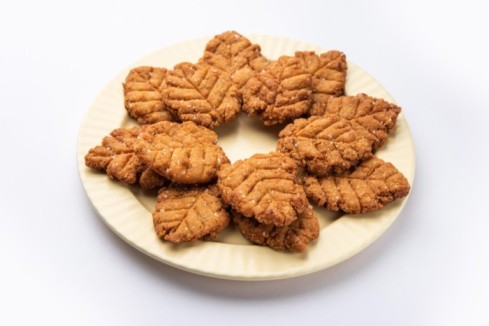
Ingredient List
Main Ingredients
Optional Aromatics & Enhancers
Instructions
recipe details
-
Prep Work
- Crush the jaggery into fine pieces
- Dry roast the fennel seeds lightly until fragrant
- Keep your wheat flour sieved and ready
-
Making the Dough
- In a large bowl, mix the wheat flour and crushed jaggery
- Add the roasted fennel seeds and any optional aromatics you're using
- Now, add the ghee and start mixing with your fingers
- Gradually add water, little by little, kneading into a firm dough
- Cover and let it rest for 15 minutes
Pro Tip: The dough should be firmer than regular roti dough. If it's too soft, your Thekuas might break while frying.
-
Shaping the Thekuas
Traditional Method:
- Take a lemon-sized portion of dough
- Roll it into a ball
- Press it into the Thekua mold
- Tap gently to release the designed cookie
Don't have a mold? No worries! Try these alternatives:
- Use a cookie cutter
- Make simple patterns with a fork
- Press with your palm and create designs with your fingers
-
The Frying
- Heat oil in a kadai on medium heat
- Test the oil temperature by dropping a tiny piece of dough - it should rise slowly
- Slide in 4-5 Thekuas at a time
- Fry on medium heat, flipping occasionally
- Remove when they turn golden brown (about 3-4 minutes per batch)
- Drain on paper towels
-
Serve:
Our Thekua is ready to serve.




